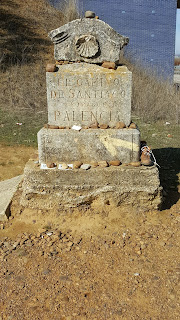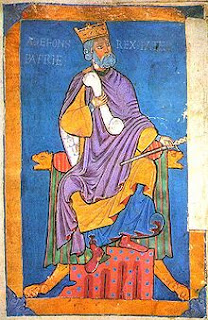We left the albergue at 7.50. Only a short walk of
16.5km was planned for the day as I was keen to stay overnight in Sahagún and
explore the historic remnants of the town which was once the most important
centre of ecclesiastical power and culture in 11th century Spain.
It was extremely chilly as we made our way out of
Ledigos and alongside the N-120, but the sun was rising and we soon came to
Terradillos de los Templarios; once a stronghold of the Knights Templar, where
we had an excellent breakfast in the Jacques de Molay albergue (named after the
last Grand Master of the Templars). The bar in the albergue was surprisingly
busy with pilgrims of different nationalities and was decorated with rustic
farm implements from times gone by. I bought myself a small handmade wooden
Templar cross to hang on my rucksack, alongside my shells and Tau cross.
 |
| Matthew approaching Terradillos |
After Terradillos, the path left the main road for
a while and we enjoyed a welcome period walking through fields on gravel tracks.
We said Morning Prayer together and Heather pointed out some wild Muscari
(Grape Hyacinths) growing beside the path. These were the first wildflowers I
had seen on the trip, which surprised me as my previous experience of walking
the Camino had been of encountering a variety of wildflowers; the landscape on
this second half of the Meseta seemed strangely barren.
 |
| Wild Muscari |
The weather by now was warming up and it was
turning into a pleasant day, but I felt a bit miserable and unhappy with my own
company and so spent a lot of the time walking by myself. Why exactly I was
feeling miserable was hard to say – probably all sorts of complex issues which,
although normally buried deep inside were rising to the surface. I find walking
the Camino does that – you are challenged not only physically, but also
emotionally, and spiritually, as the prolonged walking and silence causes things
to rise to the surface to be confronted and examined. I was starting to feel I
should like to have a period of walking away from myself and have a rest from
my own company, but of course you can’t do that and instead, you are forced
with God’s help to work through the baggage you accumulate as you go through
life.
 |
| David refreshed after second breakfast! |
By the time I approached San Nicholás del Real
Camino I was feeling a little better from the time spent in solitude. The
outskirts of the village were punctuated with the mounds and little doorways of
Bodegas; traditional underground wine cellars from the days before
refrigeration. Many of them are still used by locals to store their vintage and
I noted as we walked, that some had even been turned into houses. I imagine
they would make a cosy home with the underground rooms being warm in winter and
cool in summer. Looking at them always makes me feel I am in the Shire looking
at the dwellings of Hobbits – perhaps Tolkien got his idea from seeing Bodegas
in Spain?
The others caught up with me and we had second
breakfast (potato tortilla with a medicinal glass of Rioja to revive the
spirits!). Then from San Nicholás onwards it was a warm and slightly
uninteresting slow climb up a gradual incline shadowing the busy N-120 on our
right. Near the summit we came upon the traditional marker stone delineating
the border between the Provinces of Palencia and León. It seemed a long time
ago and many kilometres back when we had entered Palencia back at Itero de Vega
on 09/10/15 and here we were finally leaving it!
 |
| Provincial boundary stone |
At the summit of the hill, we had to walk around an
interchange slip road, which seemed to have only recently been built; we paused
to watch a Red Kite hunting along the side of the dual carriageway and then we set
off downhill towards Sahagún, which we could now see in the distance.
 |
| Roman bridge and Ermita Virgen del Puente |
After about another kilometre we crossed the N-120
down a track to the right and followed the rio Valderaduey to the Ermita Virgen del
Puente. The hermitage sits in a small grove of Poplar trees and is
reached across a picturesque little Roman bridge (although the river has moved
and no longer flows under the bridge). The area around the hermitage has been
made into a picnic site and there were sculpted metal benches to sit or recline
on. The place was cool and refreshing after our hot, dusty walk beside the
N-120 and we enjoyed shedding our bags, having a drink, and relaxing on the
benches which were surprisingly comfortable; the metal being pleasantly cool.
It was now so warm and sunny that Matthew even decided to peel his top off and
blind everyone with his very Irish blizzard-like untanned whiteness!
 |
Get your sunglasses on to combat the
blinding whiteness! |
The hermitage itself, although it has Romanesque
foundations, was built in the 12th century and it’s most interesting
feature is that it has a Mudéjar style
brickwork apse. I mentioned the Mudéjars back in Burgos when we were discussing
the monastery of Santa Maria la Real de Huelgas. The term means “tamed or
domesticated” and refers to the Muslims of Al-Andalus who remained in Spain
after the Christian Reconquista. In architectural terms, the Mudéjar style resulted from a fusion of Muslim and
Christian medieval architectural techniques, as the two cultures lived side by
side during this period. Elements of Islamic art and architecture were applied
to Christian architecture, especially in the building of Bell Towers. It is
characterised by elaborate geometric designs in brick, tile, wood, carving and
plasterwork and it is generally agreed that it first developed in 12th
century Sahagún and then spread to the rest of León and beyond – notably to the
16th century Alcázar Palace in Seville and even to Latin America.
 |
| Heather relaxing |
As
the source of this important architectural style, it was essential for me that
we should stay overnight in Sahagún so that I could see the surviving examples
of the early Mudéjar style. Matthew and Heather
were of course rolling their eyes at the mere mention of the word and had
planned an overnight escape to a local hotel to relax whilst I was doing my geeky
sightseeing!
 |
| Mudejar apse |
The other important feature of the Ermita Virgen
del Puente site is that it marks the half way point between St. Jean Pied de
Port and Santiago de Compostela! A modern brickwork monument has been erected featuring
sculptures of king Alfonso VI and the Cluniac priest Bernard de Sédirac facing
each other. It was amazing to think that I had reached the half way point of
the Camino Francés! I was excited and yet also extremely humbled and grateful
to have already got so far and enjoyed so many experiences along the way. We
posed for photographs between the sculptures which strangely, had Spanish Police
tape tied in front of them, though I have no idea why!
 |
| Mudejar apse viewed from inside |
We walked on into town through a small industrial
area and past a large, modern hotel. Then Matthew and Heather took their leave
for the moment and turned right to go up the road to stay at the Viatoris
Albergue, while David and I wandered on into town, over the sizeable railway
sidings and down the narrow streets into the town centre. We had hoped to stay
at the Benedictine Convent on Calle Nicholás, but the door seemed firmly closed
and we didn’t like to ring the bell, so walked on to the El Labriego albergue
across the road from the Convent and signed in there instead.
 |
| Half way to Santiago! |
The hospitalero in the albergue was very welcoming
and pleasant and stamped our credencials in a pleasant and inviting bar, whilst
serving us a welcome glass of lager accompanied by some tapas. He then led us
through to a courtyard where there was an adjoining modern dormitory which,
whilst modern and clean was, like the previous two albergues, extremely cold!
There were electric heaters on the walls but these were apparently of symbolic
value and e never got them to work!
We showered in the good bathroom facilities and gave
the hospitalero our laundry. It cost extra to have our clothes tumble dried. While
David took the opportunity to sit in the courtyard in the sunshine and catch up
on his journal, I had a look around. There was an aviary with beautiful
multicoloured finches, a cat and a partly grown kitten, which the Hospitalero
eventually put into a second large cage which was very spacious but which the
cats complained about vociferously.
 |
| Albergue chapel |
Off the courtyard there was also an old
stable which had been converted into a chapel for the use of pilgrims and I
would have liked to have sat there for a while to pray, except that there was
an extremely strong smell of cat urine which drove me out! Clearly the cats weren’t
always in their cage! Also in the courtyard was a medieval sarcophagus! Every
courtyard should have one!
 |
David relaxing in the sunshine
|


























